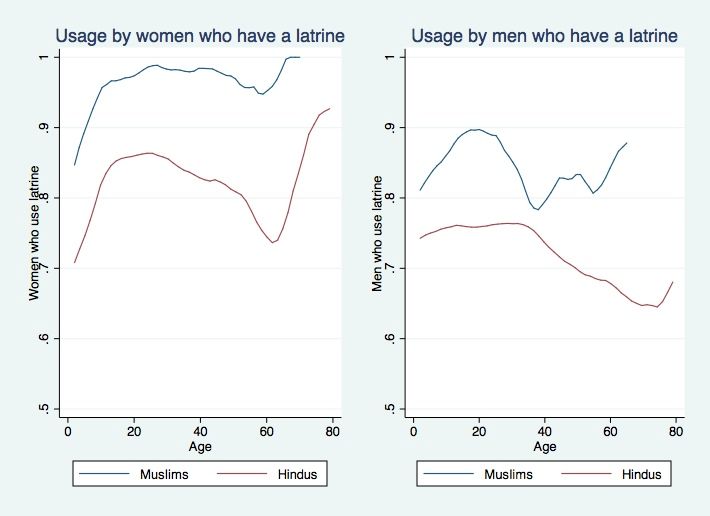What do the SQUAT data say about latrine usage and religion?
— Blog Post — 2 min read
To continue the trajectory of chart month, I’d like to share some of the data that we collected in the SQUAT Survey on latrine ownership and usage among different religious groups. The SQUAT Survey teams randomly selected and interviewed around 3,200 rural households in over 300 villages in Bihar, Haryana, Madhya Pradesh, Rajasthan, and Uttar Pradesh. For a more detailed explanation of the sampling strategy, see our SQUAT policy brief.
Among SQUAT survey respondents, 52% of Muslim households have latrines, while a smaller 43% of Hindu households do. Moreover, the graph above shows that for every level of wealth, measured using a simple sum of a series of assets, Muslim households are more likely to have a latrine than Hindu households are. These results are similar to what one would see using larger datasets like India's NFHS and the IHDS.
Now of course, one of the main contributions of the SQUAT survey is that it allows us to look at usage, not just ownership. The following graphs look at usage among people who have latrines and are chock full of interesting stuff. First, they show that for men and women of all ages, Muslims use the latrines they have more often than Hindus do. However, this difference is more prevalent among women than men, suggesting that purdah among Muslim women may be an important factor here.
The other interesting thing about these graphs is how usage changes among different age groups. Now remember, this data is cross-sectional, so it doesn't show how usage changes over time for individuals, but how usage is different right now among different age groups. Young children often defecate in the open. As they get older, both women and men tend to use their latrines more, although women of childbearing age are more likely to use than men of the same age. Older people are more likely to defecate in the open, most likely because it is their habit. It’s what they have been doing since they were children. Finally, there is an uptick in usage among the very old, probably because ailing health makes it difficult for them to walk out to the fields.
The story that these graphs tell is that in the rural areas we visited in north India, just as in larger nationally representative datasets, Muslims are more likely to own latrines than Hindus. Moreover, among those households who have latrines, Muslims are also more likely to use it. Given the consistency between different datasets, both nationally representative and focused on rural areas where the sanitation problem is concentrated, and the consistency between ownership and usage, I'm pretty convinced that this story is real.
